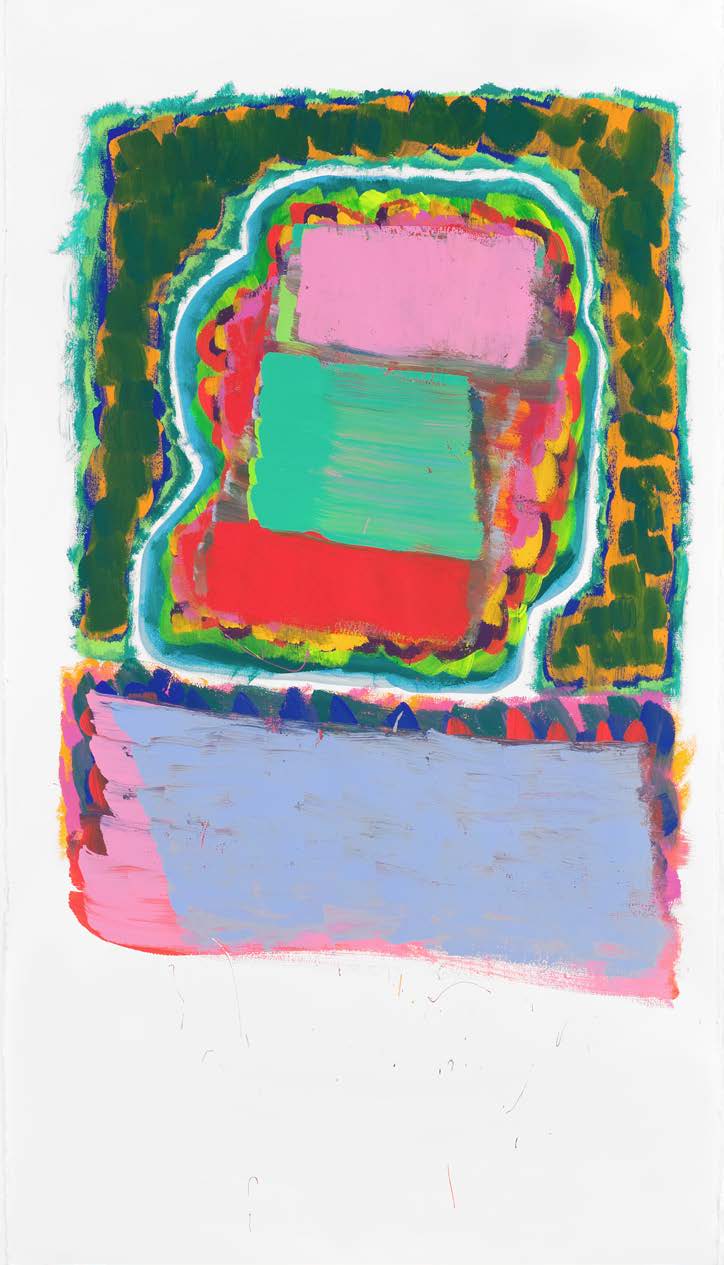GASTON-DREYFUS – FOURNIER
Fabienne Gaston-Dreyfus’s paintings have three main components. Firstly, colour: flat areas or brushstrokes overlaid and intermingling, unfailingly strong and saturated. Then the painterly act: responsive to the body and its language, the act seems at once freely improvised and tightly controlled. And lastly the spatial role of white: a fundamental element, directing the construction of the paintings and fine-tuning the balance between solids and voids. Eric Suchère homed in perfectly on Gaston-Dreyfus’s oeuvre in the gallery’s catalogue for her earlier solo show: «This is painting as an accumulation of forms/acts – infra-forms or forms in fine or forms in spite of themselves, and above all, acts: acts standing solely for themselves, presenting nothing other than themselves, leading to nothing other than themselves – except, of course, the act they sprang from.»
Gaston-Dreyfus’s most recent explorations have led her to work mainly on paper. Laid up after an accident, she had been concentrating on small formats – the Chutes (Leftovers) shown by the gallery at the Drawing Now Art Fair in 2019, followed by the Cônes (Cones) – while gradually recovering her full freedom of movement and returning to larger works. Of the several series that emerged from this period, two are on display here.
The recent pieces are medium-sized, with a central motif taking up most of the sheet and surrounded by empty space. Gaston-Dreyfus begins with an improvised freehand drawing which serves as a starting point for a construction. Colourful interlocking volumes give rise to a kind of perspective and in some of the pictures we detect the barest hint of figuration. The near-saturated treatment of colour is rendered more pronounced by vivid brushstrokes and overlays reminiscent of the formal vocabulary of Philip Guston, although the artist is uncompromisingly in favour of strong, Fauvist, Matisse-style colour. This group of works is atypical, in terms of both treatment and process: «These latest paintings revolve for the first time around a preliminary drawing. The unpainted blank space is still there because it’s always been one of the structural components of my work, but now the painted area is gaining ground.»
The Cônes series is a continuation of a method based on a repeated movement already explored in the Chutes and itself founded on a painterly aim that finds concrete expression in a concentrated, heavily textured composition. The brushstroke is insistently repeated to the point of establishing a clear fit with a conical shape. The series comprises some one hundred sheets in a kind of painting continuum, a smooth, uninterrupted flow. Here the artist’s personal selection points up the use of colour in all its nuances and infinite variations.
A feature of the exhibition is the artist’s first tapestry. Based on one of her very recent works on paper, the tapestry was made in conjunction with the Néolice workshop in central France, where the combination of a modified industrial loom, age-old skills and digital technology provides Jacquard weaving of rare precision. Via her exploratory work on texture Gaston-Dreyfus had already raised the issue of the transcription of the original. Her practice as a painter is mainly characterised by the overlaying of colour strata, which makes the simultaneous use of different-coloured threads a straightforward echo of her own painterly tactics. This isn’t the first time Fabienne Gaston-Dreyfus has «side-stepped» out of painting: as she said of a series of sculptures made in 2010, «This kind of experience isn’t unique in my career. More than once I’ve taken byways interacting or out of step with my practice, and they’ve helped me slip back easily into painting.. . . I need these displacements, they act as a breath of fresh air.»
1. Eric Suchère, Si intensément vide, in Fabienne Gaston-Dreyfus, éditions Galerie Jean Fournier, Paris, 2017, page 5.
2. Entretien lors d’une visite d’atlier, juin 2019.
